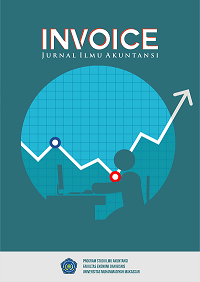ANALISIS PENGUKURAN KINERJA DENGAN PENDEKATAN BALANCED SCORECARD PADA RUMAH SAKIT SULTAN DG. RAJA BULUKUMBA
DOI:
https://doi.org/10.26618/inv.v1i1.2010Abstract
This study aims to determine the performance of Sultan Hospital Dg. King of Bulukumba when measured using the Balanced Scorecard approach. The analytical method used is descriptive analysis with a quantitative approach using hospital performance indicators in performing performance measurements. The results of the study show generally that 1) Sultan Hospital Dg. Raja Bulukumba allows to apply the Balanced Scorecard to measure organizational performance, because with the Balanced Scorecard all aspects can be measured. The application of the Balanced Scorecard is possible because the Sultan Hospital Dg. The King of Bulukumba has formulated his vision, mission and strategy and the results of the research show that the performance of Sultan Hospital Dg. The King of Bulukumba is said to be quite good when using the Balanced Scorecard. And 2) performance measurement of Sultan Hospital Dg. The King of Bulukumba using the Balanced Scorecard for a period of 2 years shows good resultsReferences
Anthony, Robert N dan Vijay Govindarajan. 2008. Sistem Pengendalian Manajemen. Jakarta. Salemba Empat.
Ayuningtyas Susanti. 2015. Pengukuran Kinerja Menggunakana Metode Balance Scorecard Pada Badan Layanan Umum Rumah Sakit Benyamin Gulu Kabupaten Kolaka. Jurusan Akuntansi.PNUP.
Fitri We Tentri Pada. 2010, Penerapan Balanced Scorecard Sebagai Tolak Ukur Penilaian Kinerja Pada Rumah Sakit Umum Daerah (RSUD) Lamaddukelleng Kabupaten Wajo. Jurusan Akuntansi. PNUP.
Horgnren,M.Datar, dan Foster. 2008. Akuntansi Biaya. Edisi 11 julid 2. Jakarta:PT. Indeks.
Kaplan, Robert S. and Norton, David P. 1996, Balanced Scorecard: Translating Strategi Info Action Bostom”. Harvard Business School.
Kaplan. Robert S dan David Norton. 2000. Balanced Scorecard: Menerapkan Strategi Menjadi Aksi. Terjemahan oleh Peter R. Yosi Pasla. Jakarta: Erlangga.
Mahmudi. 2010. Manajemen Kinerja Sektor Publik. Yogyakarta: UPP STIM YKPN.
Mahmudi. 2013, Manajemen Kinerja Sektor Publik, Yogyakarta: Unit Penerbit
dan Percetakan Sekolah Tinggi Ilmu Manajemen YKPN.
Mahsun, Mohamad. 2008. Pengukuran Kinerja Sektor Publik, Penerbit BPFE,Yogyakarta.
Mardiasmo. 2009. Akuntansi Sektor Publik. Yogyakarta: Andi.
Moeheriono. 2010. Pengukuran Kinerja Berbasis Kompetensi. Bogor: Penerbit Ghalia Indonesia.
Mulyadi. 2009. Balanced Scorecard; Alat Manajemen Kontemporer Untuk Pelipatgandakan Kinerja Laporan Keuangan Perusahaan, Cetakan Kesatu, Penerbit Salemba Empat, Jakarta.
Mulyadi dan Setyawan Johny. 2009. Sistem Perencanaan dan Pengendalian Perusahaan. Edisi Kedua. Penerbit Salemba Empat, Jakarta.
Mulyadi. 2014. Sistem Terpadu Pengelolaan Kinerja Personel Berbasis Balanced Scorecard. Cetakan Ketiga. UPP-STIM YKPN. Yogyakarta.
Peraturan Direktur Jendral Pembendaharaan Nomor per54/PB/2013 Tentang Pedoman Penilaian Kinerja Satuan Kerja Badan Layanan Umum Bidang Layanan Kesehatan. Jakarta: Direktur Jendral Pembendaharaan.
Sugiyono. 2012. Metode Penelitian Bisnis. Bandung: Alpabeta N2004 Tentang Pembendaharaan Negara. Jakarta: Sekretaris Negara Republik Indonesia.
Tunggal, Widjaja Amin. 2009. Performance Measurement and Balanced Scorecard. Harvarindo. Jakarta
Umar Husein. 2009. Riset Akuntansi. Jakarta.PT Gramedia Pustaka Utama.
Undang-Undang Republik Indonesia Nomor 44 Tahun 2009 Tentang Rumah Sakit.
Weston, J. Fred dan Thomas, E Copeland. 1995. Manajemen Keuangan. Jilid I, Edisi ke 9. Jakarta ; Binarupa Aksana.
Downloads
Published
Issue
Section
License
Authors who publish with Invoice: Jurnal Ilmu Akuntansi agree to the following terms:
Copyright Ownership
The copyright of all articles published in this journal remains with the author(s). However, the authors grant Invoice: Jurnal Ilmu Akuntansi the right of first publication with the work simultaneously licensed under a Creative Commons Attribution 4.0 International License (CC BY 4.0). This license allows others to share, copy, redistribute, adapt, and build upon the work for any purpose, even commercially, as long as proper credit is given to the original author(s) and the source.Licensing and Access
Invoice: Jurnal Ilmu Akuntansi provides immediate open access to its content on the principle that making research freely available to the public supports a greater global exchange of knowledge. All published materials are available freely without subscription or payment and can be accessed, downloaded, and reused by any user provided that appropriate attribution is given.Permission for Reuse
For uses not covered by the CC BY 4.0 license, such as commercial reprints, translations, or any form of adaptation without clear attribution, users must obtain written permission from the editorial team. Requests for such permissions can be directed to the editorial office at: [insert journal email here].Plagiarism and Originality
Authors are responsible for the originality of their submissions. All articles are screened for plagiarism using appropriate tools before acceptance. Manuscripts found to contain unoriginal content or infringing materials will be rejected or retracted as per journal policy.

